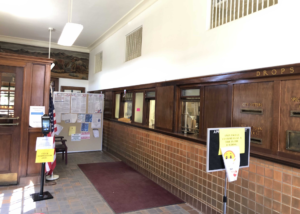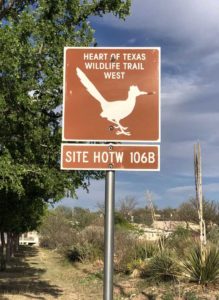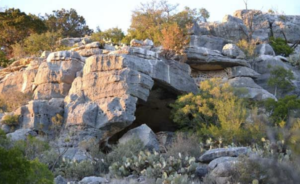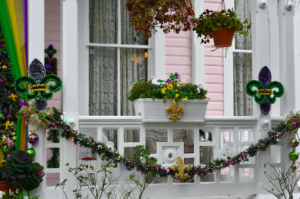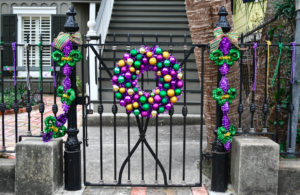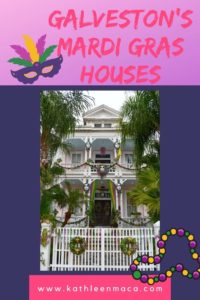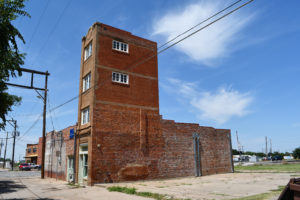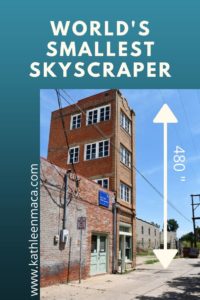Category: Architecture
Alpine’s Post Office with a View of the Past
Public art in the form of murals has become so popular in recent years, but they aren’t anything new. The next time you drive through a small town in Texas, stop into the local post office and take a look around. You might just find fine art where you’d least expect it.
Often referred to as “WPA murals,” examples of fine artwork created to enhance public buildings were actually a gift from the government to its citizens.
But, first thing’s first . . . the painting in Alpine wasn’t actually created as part of the Works Progress Administration. The WPA (I’m not going to drown you in details here) was created in 1935 as part of the “Second New Deal” to provide jobs for unemployed men during the depression. Most of the jobs were in construction, building roads, bridges, schools, parks, and airports. There were also artists recruited by the WPA, but they were given fairly free rein in the subjects they painted.
The murals I’d like to introduce you to were created by the Treasury Department Section of Painting and Sculpture which was created a year earlier than the WPA. It was later called the Section of Fine Arts. The goal of this program was to “secure for the Government the best art which this country is capable of producing.” Luckily for us, this art was contracted to decorate federally owned buildings, including hundreds of post offices around the county. That meant that everyone could enjoy fine art in their everyday lives, and the hope was that it would uplift the spirits of citizens during the hard times.
As one writer summed it up, “One boosted paychecks, and the other boosted morale.”
Professional artists (no students or amateurs could apply) entered competitions for Section assignments and were encouraged to visit the individual communities so their artwork would reflect local life or history. And unlike the WPA paintings, Section artists had to have their proposed artwork approved by committee and were limited in the subjects they were allowed to portray.

 One project of “The Section” placed artists in Civilian Conservation Corps (CCC) camps to create paintings of CCC work and life, and to make safety posters and decorate camp buildings for that project. The Section even provided sculptures to be exhibited at the New York World’s Fair in 1939.
One project of “The Section” placed artists in Civilian Conservation Corps (CCC) camps to create paintings of CCC work and life, and to make safety posters and decorate camp buildings for that project. The Section even provided sculptures to be exhibited at the New York World’s Fair in 1939.
By the end of the program (brought on by World War II) 1,047 murals and 268 sculptures had been created – which is pretty darn amazing. You can still find some of them today, but many have been lost due to building restorations, demolitions or public buildings being bought by private owners.
Anyway….
That’s why I went looking for an example in Alpine on a recent trip through West Texas. The subject especially spoke to me, since it portrays people reading. And nothing makes the heart of someone who writes books happier than seeing someone reading!
It was installed in 1940 inside the town’s new post office which was built by…you guessed it…the WPA.
The building on the corner of 6th Street and Avenue E served as the town’s post office through 2000, when it became the appraisal office for Brewster County. Since that building is open to the public, you can still see the mural in person during weekday business hours. You just have to walk a bit to the left and peer around a few light fixtures and bulletin boards!
 In 1939, a Spanish-American artist Jose Moya del Pino (1891-1969) living in San Francisco entered a TDSFA competition to paint a post office mural in San Antonio. His design depicting Sam Houston and the Alamo didn’t win, but he received a consolation assignment at the new Alpine building. The sketches he submitted with a “View of Alpine” did the trick that time.
In 1939, a Spanish-American artist Jose Moya del Pino (1891-1969) living in San Francisco entered a TDSFA competition to paint a post office mural in San Antonio. His design depicting Sam Houston and the Alamo didn’t win, but he received a consolation assignment at the new Alpine building. The sketches he submitted with a “View of Alpine” did the trick that time.
Jose couldn’t afford to travel to Texas to take a look at the town for ideas, so he asked for suggestions from the local postmistress, who told him about the local college, cowboys and scenery. From there he went to work painting this 4’ x 12’ work in oil on Masonite. He even used a neighbor who happened to own a hat and boots as his model for the cowboy.
When he completed the work in 1940, he accompanied it to Alpine for the installation and unveiling. The depiction of three locals relaxing with books on a hillside, with the Twin Sisters Peaks and Sul Ross State College (now University) in the background were a hit. The only question one local had was why a cowboy would be reading when the cattle were roaming unattended. (A valid question from someone who would probably never let that happen!)
I love the style and subject matter of this painting. It portrays an idealized but beautiful vision of our state, and it was well worth the stop whether you call it a Section or WPA creation.
Now, who’s ready to go out and hunt down a few more these treasures?
Looking for Buchel County’s Lock-up
Old, abandoned stone building? (I’m slowing down as I’m driving by.)
Bars on the door and windows? (I’m definitely stopping.)
My first guess that this had to be an old jail turned out to be right on target.
This lonely structure was the Buchel County Jail back when Marathon Texas was the county seat between 1887 and 1897.
 Wait . . . Buchel County? Nope, you’re not losing your marbles. There’s no Buchel County in the Lone Star State! Both Buchel and Foley Counties were absorbed into Brewster County – now the largest county in Texas – when their populations failed to flourish as well as expected.
Wait . . . Buchel County? Nope, you’re not losing your marbles. There’s no Buchel County in the Lone Star State! Both Buchel and Foley Counties were absorbed into Brewster County – now the largest county in Texas – when their populations failed to flourish as well as expected.
There was good reason to want a sturdy jail in town. West Texas was still a pretty wild place filled with cantankerous cowboys and outlaws back then.
But before the town had an actual building for that purpose, a windmill in the middle of North First Street was Marathon’s first jail. Drunks and other petty offenders were chained to one of its legs, and serious offenders were taken down the road to the Alpine jail.
Later, a one-room adobe house behind French’s Store served as a jail but, after several colorful escapes, locals decided that a better “calaboose” was in order, so this rock jailhouse was built.
It was constructed just south of the old Ritchey store in town, of rocks dug from a ledge on the northwest side of town. Talk about working with on-hand materials!
I can’t even imagine how hot it was inside this jail during the hot west Texas summer months!
When the Alpine jail was remodeled in 1901, their two old “cages” manufactured by Diebold Safe and Lock were brought to this location and installed. If you peer through the boars on the front door you can easily read the identifying word “L. T. Noyes – Houston, Texas” on the cell locking mechanism on the wall.
 Now this is pretty neat for fans of old-times Texas. Lucius T. Noyes was an agent for the Diebold Safe & Lock Company of Canton, Ohio. From his Houston office on the corner of Congress Avenue and San Jacinto Street he established a far reaching reputation in the world of “security.”
Now this is pretty neat for fans of old-times Texas. Lucius T. Noyes was an agent for the Diebold Safe & Lock Company of Canton, Ohio. From his Houston office on the corner of Congress Avenue and San Jacinto Street he established a far reaching reputation in the world of “security.” 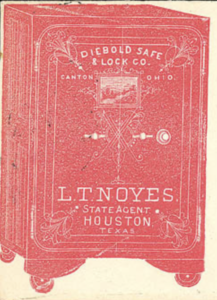
In addition to selling and installing over 50 county vaults and safes in Texas, Louisiana and surrounding states; and countless of the same for banks – he became quite a celebrity as a jail builder.
He sold the steel and iron fittings for the facilities and personally oversaw the construction and contract work for over 100 jails including this one, the impressive 1897 Fort Bend County Jail that now serves as the Richmond Police Department, the 1887 San Jacinto County Jail in Coldspring, the 1894 Glasscock County Jail in Garden City, and the 1886 Live Oak County Jail in Oakville.
I imagine he wasn’t too popular with the bad guys!
 Stealing a peek through the door and windows, it looks like there might have been a museum at Marthon’s little jail at some point, and the decaying remnants are admittedly a bit creepy. That mannequin will definitely take you off guard, but you can clearly see the jail cells, photos of what are probably local lawmen of the past on the wall, and broken display cases – whose contents I can only hope were safely removed before the damage. I’d love to see this “attraction” re-opened for a closer look.
Stealing a peek through the door and windows, it looks like there might have been a museum at Marthon’s little jail at some point, and the decaying remnants are admittedly a bit creepy. That mannequin will definitely take you off guard, but you can clearly see the jail cells, photos of what are probably local lawmen of the past on the wall, and broken display cases – whose contents I can only hope were safely removed before the damage. I’d love to see this “attraction” re-opened for a closer look.
You can find the former Buchel County Jail in Marathon behind the Ritchey Brothers building on South 2nd Street between Avenues C and D.
Ozona – The Biggest Little Town in the World
Biggest little town in the world, indeed!
Ozona is the only community in Crockett County which is the size of Delaware. Yep, the only one! It’s about an hour southwest of San Angelo, 398 miles from Houston and 347 miles from El Paso. Which makes it a pretty good jumping-off point for a lot of directions.
But before you zoom through, consider stopping for some of the unique things that Ozona has to offer. We scheduled an extra night on our trip to Big Bend to give us time to wander around and explore . . .and to give the ol’ accelerator-foot a break.







If you follow my blog or instagram account, you’ve probably figured out by now that I’m a sucker for historic courthouse buildings. I was happy to finally see this one in person.
The 1902 Second Empire courthouse of Crockett County – named after the legendary Davy Crockett – is the centerpiece of town. Designed by Oscar Ruffini, one of a pair of proliferate brother architects who kept busy populating Texas with their creations. Oscar also designed the Sutton County Courthouse, Tom Green County Courthouse and Ozona High School, and his brother Frederick Ernst designed the Concho County Courthouse, Bastrop County Courthouse, former Blanco County Courthouse (now restored) and the Millet Opera House in Austin.
 The courthouse was made from stone quarried on nearby property owned by the Crouch and Meyer families, and cost a whopping $30,000. In 1909 an arc light was added to the steeple to signal the sheriff (the Batman beacon comes to mind!) and guide travelers to town.
The courthouse was made from stone quarried on nearby property owned by the Crouch and Meyer families, and cost a whopping $30,000. In 1909 an arc light was added to the steeple to signal the sheriff (the Batman beacon comes to mind!) and guide travelers to town.
It was far more than a courthouse for Ozona and surrounding communities though, and served as a social center for cowboy dances, roundup celebrations, Christmas trees and box suppers (which reminds me of a particular scene from the musical Oklahoma!).
If the bull’s eye or “ox eye” circular moldings the mansard roof look like they’re missing something…they are! They were originally intended as a place for clock faces that were never installed. At one point in the past it bothered the locals enough to paint clocks in the features. When the courthouse was recently restored it was decided to leave them as is.
 A memorial statue of Davy Crockett stands nearby on the square. Placed on its base in 1938, it was carved from two slabs of granite weighing nearly 20 tons (well, after all – he WAS a heavyweight of Texas history!), and is inscribed with Crockett’s motto, “Be sure you are right, then go ahead.” Still seems like sound advice.
A memorial statue of Davy Crockett stands nearby on the square. Placed on its base in 1938, it was carved from two slabs of granite weighing nearly 20 tons (well, after all – he WAS a heavyweight of Texas history!), and is inscribed with Crockett’s motto, “Be sure you are right, then go ahead.” Still seems like sound advice.
“The Tie that Binds” is an emotional bronze stands at the center of the square just a few strides away from Davy to remind visitors of the perseverance of their pioneer ancestors. At life-and-a-quarter size, it makes quite an impression close up!
Just across the street is the former Hotel Ozona (not to be confused with the former Ozona Hotel . . . th ey could have used a bit more imagination, evidently). The three-story mission style inn was built in 1927 to attract tourists along the Old Spanish Trail. See more of my photos of this abandoned beauty and find out more about the OST here.
ey could have used a bit more imagination, evidently). The three-story mission style inn was built in 1927 to attract tourists along the Old Spanish Trail. See more of my photos of this abandoned beauty and find out more about the OST here.

I really appreciate visitors centers that are more than a room filled with pamphlets, and the Ozona Chamber of Commerce and Visitor Center (505 15th Street) is definitely worth a stop (even if it’s just to see this cocky granite Texas sporting a Stetson). The building is bright and welcoming, and the staff are versed in numerous local and area attractions that might peak your interest.
Across the parking lot is the Crockett County Interpretive Trail (free to visit) showcasing native plants that can b e found within 100 miles of Ozona. The short trail (like a small park) has over 200 plants representing over 75 species, each identified b
e found within 100 miles of Ozona. The short trail (like a small park) has over 200 plants representing over 75 species, each identified b y an inscribed stone. We were lucky to stop by in spring when several of the plants were showing off their blooms, but the display would be fascinating year round. Botanists and gardening fans will get a kick out of this detailed brochure of the exhibit.
y an inscribed stone. We were lucky to stop by in spring when several of the plants were showing off their blooms, but the display would be fascinating year round. Botanists and gardening fans will get a kick out of this detailed brochure of the exhibit.
Off-roaders will definitely want to venture out to the Escondido Draw Recreational Area, a 3,500 acre, 110 mile trail for all-terrain vehicles, dirt bikes and 4-wheel drives.
 After driving all day and seeing a bit of town, we were ready to sit down for a good meal, the The Hitching Post Steakhouse (1301 Old Highway 290) came highly recommended. Actually, on some days of the week like we arrived on it’s pretty much the only game in town, but that’s just fine.
After driving all day and seeing a bit of town, we were ready to sit down for a good meal, the The Hitching Post Steakhouse (1301 Old Highway 290) came highly recommended. Actually, on some days of the week like we arrived on it’s pretty much the only game in town, but that’s just fine.
We were a bit confused when we pulled into the parking lot filled with at least two dozen fire trucks and resc ue vehicles from all over Texas until we realized there was a firemen’s convention in town. But we definitely took that as a good sign, because let’s be honest – firemen know their food!
ue vehicles from all over Texas until we realized there was a firemen’s convention in town. But we definitely took that as a good sign, because let’s be honest – firemen know their food!
 The western theme, come-as-you-are restaurant probably hasn’t been redecorated much in the last few decades, which the faded photos of Old West Outlaws and cowhide on the wall, heavy wooden club chairs and indoor/outdoor carpeting will attest to – but you won’t care a bit once your food arrives. If you’re looking for good food at reasonable prices, The Hitching Post fits the bill.
The western theme, come-as-you-are restaurant probably hasn’t been redecorated much in the last few decades, which the faded photos of Old West Outlaws and cowhide on the wall, heavy wooden club chairs and indoor/outdoor carpeting will attest to – but you won’t care a bit once your food arrives. If you’re looking for good food at reasonable prices, The Hitching Post fits the bill.
A smoking room on one side has pool tables and the bar, and the other side of the building has non-smoking seating. An outdoor patio is also a good option for dining on fair weather days.
Thirsty for something stronger than tea? Be forewarned that the restaurant charges a $5 club fee to “join” to order alcohol.
 Since we hadn’t worked up big appetites we decided to split a couple of appetizers, and settled on marinated cube steaks and 1/2 order of fried mushrooms. The portions were generous and deliciously seasoned. Thank heaven the waitress suggested we choose a half order of mushrooms, since a full order would have fed half the firemen in the room.
Since we hadn’t worked up big appetites we decided to split a couple of appetizers, and settled on marinated cube steaks and 1/2 order of fried mushrooms. The portions were generous and deliciously seasoned. Thank heaven the waitress suggested we choose a half order of mushrooms, since a full order would have fed half the firemen in the room.
I’ll definitely go back to try the chicken fried steak next time I’m in town. The fact that they’re open until 11 p.m. makes it easy if one of your day trips from Ozona runs a bit longer than expected.
If you have a bit more time during your visit to Ozona, you might want to explore:
-
Crockett County Museum
-
Fort Lancaster State Historic Site in Sheffield
-
Caverns of Sonora (34 miles)
Accommodations: We enjoyed our stay at the Holiday Inn Express Hotels & Suites. The staff was friendly and the rooms were lovely and clean. Just be aware that if you’re booking because you find a great rate, there might be unexpected charged added at checkout. Our $111 rate (which was one of the selling points that helped us decide to make Ozona a stop)— ended up costing about $165 which is a heck of a difference and more expensive than any of the other stays on our 10-day trip!
Hotel Ozona- Nothing But Vacancies
While taking photos of the county courthouse in Ozona, I turned around to see the remains of Hotel Ozona, and couldn’t resist getting a closer look. Obviously once a beautiful hotel and it was easy to imagine it surrounded by cars and people carrying in their finest leather luggage for a stay along a road trip adventure.
 Ozona is a fairly small town, but its position along the Old Spanish Trail would have brought a lot of visitors a few decades ago.
Ozona is a fairly small town, but its position along the Old Spanish Trail would have brought a lot of visitors a few decades ago.
The Old Spanish Trail (also known as OST to many Texans), was a 2,750 mile long roadway that reached from ocean to ocean – St. Augustine, Florida to San Diego California. The headquarters for the project was in San Antonio, where an executive committee of prominent businessmen met weekly at the Gunter Hotel from 1915 until it was completed in the 1920s.
Perfectly timed for a nation that was enjoying a newfound enjoyment of “auto touring,” hotels and restaurants began appearing long the route just as they did later on Route 66. If traveled from one end to the other, tourists would cross eight states and 67 counties along the Southern United States!
Although promoters for the OST claimed that it followed the route used by Spanish Conquistadors 400 years earlier, there wasn’t actually a continuous trail from Florida to California that long ago.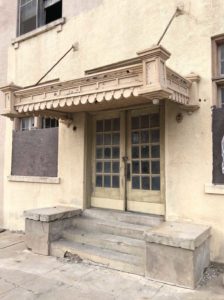
The three-story Hotel Ozona was built in 1927 for $150,000 from reinforce concrete, hollow tile and stucco, to provide stylish accommodations for the influx of tourists coming through the area. The hotel was a busy center of social life for the community for the next twenty years as well, hosting conventions, luncheons, bridge clubs, organization meetings. wedding receptions and more. The Comanche Ramblers, Fort Stockton’s string band, played for old time dances in the ballroom.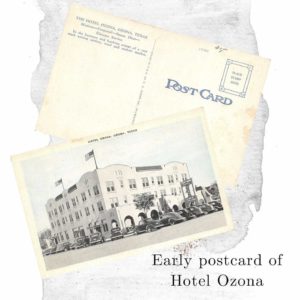
But the party didn’t last forever. In 1948 notices appeared in Texas newspapers advertising the 41-room hotel and its newly equipped kitchen for sale for a mere $8,500, due to the dissolution of a partnership. Travelers along the OST lightened in favor of other, newer highways resulting in many of the once-thriving businesses along its path to close down.
For whatever reason, the Hotel Ozona closed its doors, and never reopened. A peek in the few windows that aren’t boarded up don’t reveal many distinctively original design features other than the from desk, stairway and wrought iron railings.
The old neon sign touting air-conditioned rooms still stands tall, minus most of the neon. 
So she sits and wait for someone to come to her rescue. With the revival of so many older properties in recent years, I’m crossing my fingers that her patience will pay off.
Waxahachie’s Courthouse Square Kaleidoscope
Waxahachie courthouse Square kaleidoscope takes looking at the world through rose colored glasses one step further. The Internet active artwork created by Eddie and Mary Elizabeth Phillips sits on the corner of Main and College Street, just across the street from the fabulous Ellis County Courthouse. You overlook it if you’re as entranced with courthouse architecture as I am, but it’s worth looking for! It takes the cardboard kaleidoscopes of our youth to a while new level.
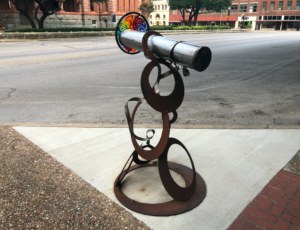 Built of scrap metal and stained glass, visitors can spin the glass wheel at one end and then look through the triangular opening at the other for a burst of ever changing colors. And the installation is near the corner streetlight it can even be enjoyed at night. (Good thinking!)
Built of scrap metal and stained glass, visitors can spin the glass wheel at one end and then look through the triangular opening at the other for a burst of ever changing colors. And the installation is near the corner streetlight it can even be enjoyed at night. (Good thinking!)
Click these links to see videos of this kinetic beauty in action, and then make a note to give it a spin yourself when you’re in the area!
Were you as fascinated with kaleidoscopes as a kid as I was?
Galveston’s Mardi Gras Houses
Looking for Mardi Gras festivities that are socially distant? Galveston Island has your answer.
Galveston Island has been celebrating Mardi Gras with citywide celebrations since 1871, and with private parties before that.
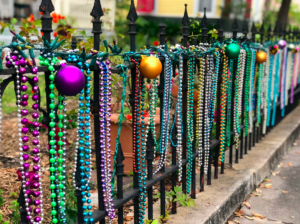 The town may be covered in sparkling lights for the Christmas season, but it bursts out in gold, green and purple for Mardi Gras. If you pass the houses at night and think you spot a Christmas tree inside a window, it’s most likely a Mardi Gras tree instead.
The town may be covered in sparkling lights for the Christmas season, but it bursts out in gold, green and purple for Mardi Gras. If you pass the houses at night and think you spot a Christmas tree inside a window, it’s most likely a Mardi Gras tree instead.

The annual parades have been cancelled this Carnival season for safety’s sake, but that won’t stop Galvestonians and their visitors from having fun. Taking a cue from New Orleans, instead of floats this year you’ll find “house floats” around the island.
Members of the Krewe of Saints who decorated their own homes complied a list of addresses so others can enjoy the fun. You can find an interactive map here.
 On Saturday, February 13th between 5 and 7 p.m., some of the participating houses will have beads and surprises for strolling revelers in their neighborhoods.
On Saturday, February 13th between 5 and 7 p.m., some of the participating houses will have beads and surprises for strolling revelers in their neighborhoods.
If you’re driving through the neighborhoods rather than walking, be aware that some of the streets are one way. There are often quite a few cars parked in front of the houses, making the streets narrower to navigate.
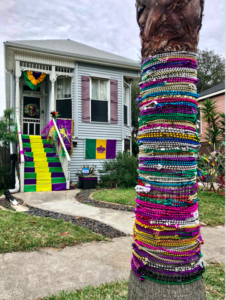 Of course, there are more homes decorated than the ones owned by this one Krewe, and the best way to see them all is to drive or walk the streets looking for the festive trimmings. If you only have a limited time, I would suggest exploring Sealy an Ball Avenues.
Of course, there are more homes decorated than the ones owned by this one Krewe, and the best way to see them all is to drive or walk the streets looking for the festive trimmings. If you only have a limited time, I would suggest exploring Sealy an Ball Avenues.
If you’re looking for some edible treats to keep up your Mardi Gras energy, you can find Mardi Gras bagels and cookies at Patty Cakes Bakery, king cakes at Maceo Spice Company and delicious seafood gumbo at the Black Pearl.
Have fun and Laissez les bon temps rouler!



World’s Smallest Skyscraper: How a Con Man Gave Wichita Falls a Claim to Fame
How could a city invest a fortune in a “high-rise” that’s only about forty feet tall? This building’s tale should appear in the dictionary as the definition of “hoodwinked.”
In 1912, a large petroleum reservoir was discovered west of the city of Burkburnett, a small town just outside of Wichita Falls. Of course everyone was pretty happy about the financial windfall that ensued, but it also brought more people and businesses to town that wasn’t prepared to house them. People were so desperate that they were even conducting business in tents pitched on street corners. What Wichita Falls needed was more office space!
There was a one story building on the corner of Seventh and LaSalle Streets built by Augustus Newby in 1906 that was ideally located near the downtown railway depot. One of its tenants, J. D. McMahon, had a construction firm in there and say what he thought was a shining opportunity.
 In 1919 he proposed to build a high-rise annex next to the Newby Building that would provide multiple floors of space for commerce to the boomtown. Sounds like a great idea, right? That’s what the city leaders thought, too.
In 1919 he proposed to build a high-rise annex next to the Newby Building that would provide multiple floors of space for commerce to the boomtown. Sounds like a great idea, right? That’s what the city leaders thought, too.
McMahon drew up impressive looking blueprints (though he wasn’t an architect) and showed them to potential investors, who forked over $200,000 in capital for the building’s construction. That’s the equivalent of $2.8 million in today’s money!
He proceeded with the construction of the skyscraper, but used his own construction crew to control and oversee the project.
Locals evidently turned their attention elsewhere as the building was being raised, because it was almost completed before they noticed that something was wrong. Their high-rise tower wasn’t what they had envisioned. Instead of the 480-foot structure thy expected; McMahon had built a 480-inch building.
The brick embarrassment was only eighteen feet deep, ten feet wide and each of the four floors had only 118 square feet of space on each of the four floors.
 It’s been referred to as a glorified elevator shaft, which is especially ironic since the crew originally hired to install an elevator backed out of the project. The only way to access the upper floors was by an external ladder (until an interior staircase was built years later).
It’s been referred to as a glorified elevator shaft, which is especially ironic since the crew originally hired to install an elevator backed out of the project. The only way to access the upper floors was by an external ladder (until an interior staircase was built years later).
Infuriated investors took McMahon to court, sure that they would find justice for the con. But they had one more surprise in store.
Even though the judge was sympathetic to their complaints, he had to rule in favor of McMahon. What none of the financers had noticed in their excitement and rush to sign off on the project is that the blueprint listed the building’s dimensions in inches – not feet. It was build to the specifications proposed – 480” not 480’. Oh, the different an apostrophe makes!
The narrow stairs that were built a few years later took up twenty-five percent of the interior space, making it even smaller.
How could the situation possibly be worse? McMahon had never gotten permission from the property’s owner, who lived in Oklahoma, to build on the lot!
Needless to say, the Newby-McMahon Building was quite an embarrassment for local officials. The oil boom ended shortly after the building was completed, and it was boarded up and fell into disrepair.
Once the economy regained its footing, several small businesses operated in the snug spaces of the structure, including a barbershop and restaurants. It is now home to an antique shop on the bottom floor, and artist studios above.
Luckily, the building has survived several potentially fatal events including a fire, a 2003 tornado, and attempts by locals to have it demolished.
Wichita’s City County granted $25,000 in funds for the building’s restoration in 2005. Now, it’s true that that’s as much as it cost to build it in the first place – but that was a different time. Now the people of this Texas town have a reminder of the oil boom, a curiosity of visitors and something to point to and tell an amazing tale.
It might be difficult to spot from a distance because there’s more “sky” than “scraper,” but it’s worth stopping by to see this scam-tastic little piece of Texas history.
Lady Bird Johnson’s Haunted Childhood Home
When I hear the name Lady Bird Johnson, I immediately think of wildflowers. She was, after all, a visionary environmentalist who focused on protecting and preserving North America’s native plants, including Texas wildflowers.
But did you know that Texas native Lady Bird Johnson grew up in a haunted house?
High on a hill 2 ½ miles outside of Karnack, Texas an isolated white mansion surrounded by trees, fields and bayous houses a special place in Texas history — as well as its very own ghost.
The imposing, 17-room plantation style mansion known as the Brick House was built in 1843 by Cephus Andrews. It was also the site of a tragedy.
In 1861 during a violent thunderstorm, Andrews’ 19-year-old daughter Eunice, known as “Oonie,” sat in her bedroom beside a fireplace. Lightning struck the chimney and raced downward striking the young girl and consuming her in flames.
Legend has it that Oonie’s spirit has never left the home. Stories have been passed down through the years of eerie noises, ghostly apparitions, misplaced objects and other odd occurrences…all attributed to poor Oonie.
 In 1902 the Andrews family sold their home and thousands of acres of cotton to the wealthiest man in town, Thomas Jefferson Taylor. He also owned two cotton gins, a fishing business and two country stores emblazoned with boastful signs stating “T. J. Taylor—Dealer in Everything.”
In 1902 the Andrews family sold their home and thousands of acres of cotton to the wealthiest man in town, Thomas Jefferson Taylor. He also owned two cotton gins, a fishing business and two country stores emblazoned with boastful signs stating “T. J. Taylor—Dealer in Everything.”
 Taylor and his wife Minnie had two sons, and in 1912 added their only daughter Claudia Alta Taylor. Her nursemaid took one look at the dark-haired baby and said she was “as purty as a lady bird.” The endearing nickname followed her throughout her life.
Taylor and his wife Minnie had two sons, and in 1912 added their only daughter Claudia Alta Taylor. Her nursemaid took one look at the dark-haired baby and said she was “as purty as a lady bird.” The endearing nickname followed her throughout her life.
 When Lady Bird was 5, the Brick House witnessed a second tragedy. Her mother fell down the staircase of the home and died a few days later from complications of a miscarriage caused by the accident.
When Lady Bird was 5, the Brick House witnessed a second tragedy. Her mother fell down the staircase of the home and died a few days later from complications of a miscarriage caused by the accident.
Lady Bird, whose brothers were away at school (and weren’t even told about their mother’s death for almost a year), remained in the home and was raised by her maternal aunt Effie who came from Alabama to live at the home.
When asked about the Brick House’s ghost in later years, Lady Bird would say that she often had a feeling of apprehension and unease in the home. She spent most of her indoor time in her room, which was just down the hall from Oonie’s room that servants repeated warned her to stay away from…as they did. The sounds of the old house, including wind whipped through the sills of the floor to ceiling windows must have added to the spooky atmosphere.
Her aunt Effie believed that Minnie’s ghost visited her at night to instruct her about caring for Lady Bird, washing windows and taking care of other forgotten household chores.
In her 80’s Lady Bird told her biographer, “I would not, even now, at this age, feel comfortable being alone in that house myself.”
Luckily young Lady Bird was able to spend most of her time outdoors strolling through the woods and fields where she developed her love of nature’s beauty. So it’s perhaps indirectly thanks in part to the ghost of forever-young Oonie that Texas enjoys wildflowers along its highways each spring.
The home still stands as a national historic landmark, and is privately owned. I wonder if Oonie still provides caretaking instructions to them.
Road Trip Rest Stops – Enjoy the Ride
Starting off a new year usually begins with lofty goals quickly filling up our calendars. But it’s probably the ideal time to make a decision to slow down and enjoy the ride.

When I was growing up, family car trips looked a lot different than they do today. The journey and taking in the sights of the places we traveled through were just as important and fun as the places we were going to.
While a modern day family is more likely to think of Bucee’s when someone mentions a rest stop, (we had our version of that too back in the day, in the form of Stuckey’s) the roadside rest stops were something entirely different.
Families didn’t scurry out of the car and head in different directions with the goal of loading up their arms with snacks and souvenirs.
 Instead small clusters of roadside rest stops, basically roofed spots with picnic tables, dotted the sides of the two-lane blacktop highways and offered travelers a place to get out of their car and stretch their legs, let the kids run off some excess energy, and unload their hamper of food Mom had packed that morning to enjoy a family picnic while taking in a view.
Instead small clusters of roadside rest stops, basically roofed spots with picnic tables, dotted the sides of the two-lane blacktop highways and offered travelers a place to get out of their car and stretch their legs, let the kids run off some excess energy, and unload their hamper of food Mom had packed that morning to enjoy a family picnic while taking in a view.
Texas is lucky to still have a wide variety of these mid-century rest stops, so it might come as a surprise that other states have taken to demolishing theirs. Along Texas highways you might spot some shaped like teepees, with wagon-wheel sides, retro-curved roofs or just simple, functional designs. They bring back great memories of time spent on family vacations, and rank right up there with folded maps from gas stations on the nostalgia scale.
I’ve never gotten over my love of road trips, which is a mystery to some of my friends who would rather fly somewhere that’s only a couple of hundred miles away. But I’ve noticed with all of the challenges in the past few months that many Americans are rediscovering the love of road trips, whether they are going across the state or across the country.
And, yes, I’ll make the time to take a few minutes at lovely spots I find like this one, because they’re just as enjoyable when I’m traveling by myself.
Take it from me, and rush less the next time you’re driving along to a destination. If you see a nice roadside rest area, take the opportunity to pause for a few minutes, enjoy a drink or snack and the view. It can put a whole new perspective on your trip.
What road are you planning to follow in 2021?












